This year at our Spring Recital, I decided to ask a friend to take photos. I just received the photos from her and I love how this group photo turned out!

This year at our Spring Recital, I decided to ask a friend to take photos. I just received the photos from her and I love how this group photo turned out!

Over the past few months, I have received many inquiries asking when the Level 3 Rhythm Cards will be available in the Shop. I am so pleased to announce that they are here!
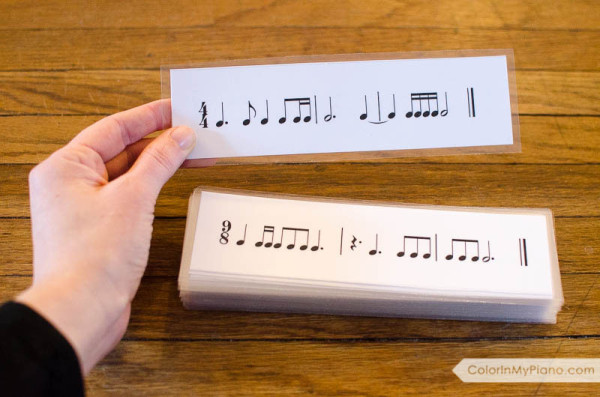
As with the other items in my Shop, the rhythm cards are a PDF download that includes the license to print from the PDF as much as desired for use with your own students. The Level 3 PDF contains 22 pages of rhythm cards (5 on a page), for a total of 110 cards. These cards work great for a variety of games (such as Swat-A-Rhythm, the Rhythm Train Game, or the BANG! game) and also work well to send home with students as part of their weekly assignments.
Each card contains a three- or four-measure rhythm example. The rhythm examples in Level 3 use ties, sixteenth rests, and various combinations of sixteenth notes with eighth notes. The time signatures used are 3/4, 4/4, 6/8, 9/8, and 12/8 time.
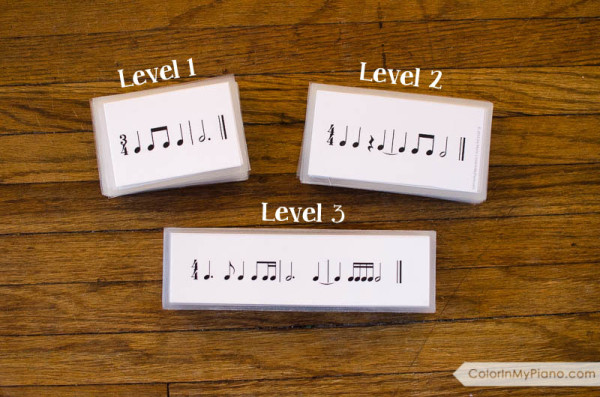
On Saturday, my students performed at our annual Spring Recital. (I know it is not technically Spring yet — just wishful thinking!) We had a great day and I’m so proud of my students and their hard work.
Here is a peek at this year’s recital program:
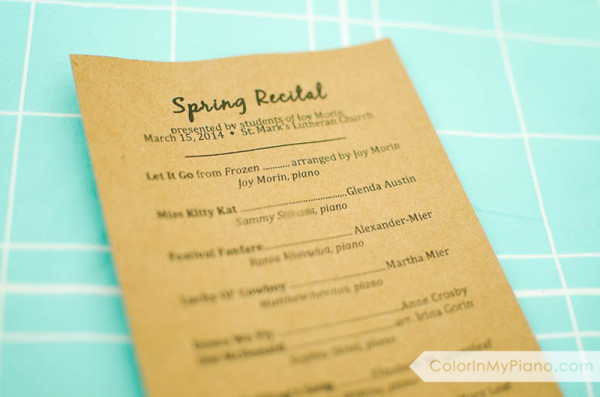
My students are currently preparing pieces for a local Ribbon Festival as well as my studio’s annual recital. (I always hold my Spring recital in March or April — I think May gets too busy!)
In order to help prepare them for these events, I decided to ask my friend, Loretta, to give a master class for my students during our “Piano Party” group class this month. Loretta and I became friends during grad school while earning our pedagogy degrees. She currently runs a multi-teacher studio in Lansing, Michigan.
Loretta loved the idea and asked if I would give a master class for her students in return. It turned out to be a great exchange and a very positive experience for all of our students!
Here is a group photo of me with some of Loretta’s students after our master class:
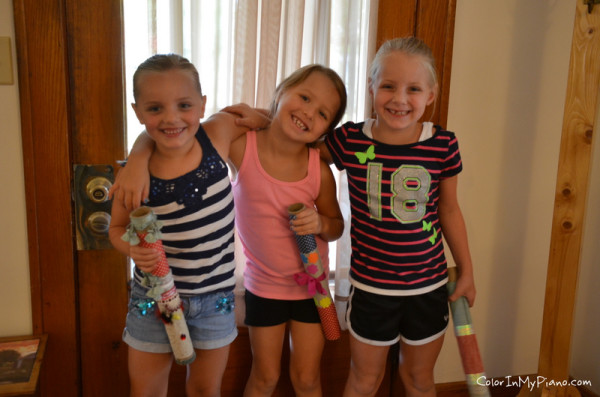
Are you thinking about holding any camps/workshops this summer? Here are some great reasons to consider holding camps:
Here is what I do during the summer months. This is pasted directly from my Studio Policies:
Summer Months: During the summer months (June _ through August _), private students are expected to continue taking lessons; however, they have two options:
Not only does the teacher feel strongly about the value of continuing the student’s musical education throughout the summer months, but the teacher’s livelihood depends upon a regular income throughout the summer months because the tuition rate has been determined based on a 12-month calendar. For these reasons, if a student does not continue lessons through the summer, the student unfortunately cannot be guaranteed a spot in the schedule in the Fall especially if there is a waiting list.
For either option, students are expected to continue paying the flat monthly tuition rate. This system has worked very well for the past two years and I plan to do it again this summer (2014).
Be sure to crunch the numbers for a different scenarios until you find a tuition rate that is profitable for your business but also reasonable for your students. For example…
Scenario 1: Let’s suppose you charged $100/student for an 8-hour camp (4 days, meeting 2 hours each day).
Looking at these numbers, I would probably decide that this tuition rate is not profitable in the event that only 4 students register. Therefore, I would either set my minimum number of students to 6 (which means risking that I might have to cancel the whole thing if I don’t get 6 registrants), or set a higher tuition rate.
This is just a scenario for how you might go about deciding what rate is right for you and your area. I’m not trying to suggest a particular tuition rate, but rather show you how to think through the numbers. 🙂 Here is another scenario.
Scenario 2: Let’s suppose you charged $60/student for a 4-hour workshop (1 day).
As you can see, the success of your camp depends largely on how many students will register!
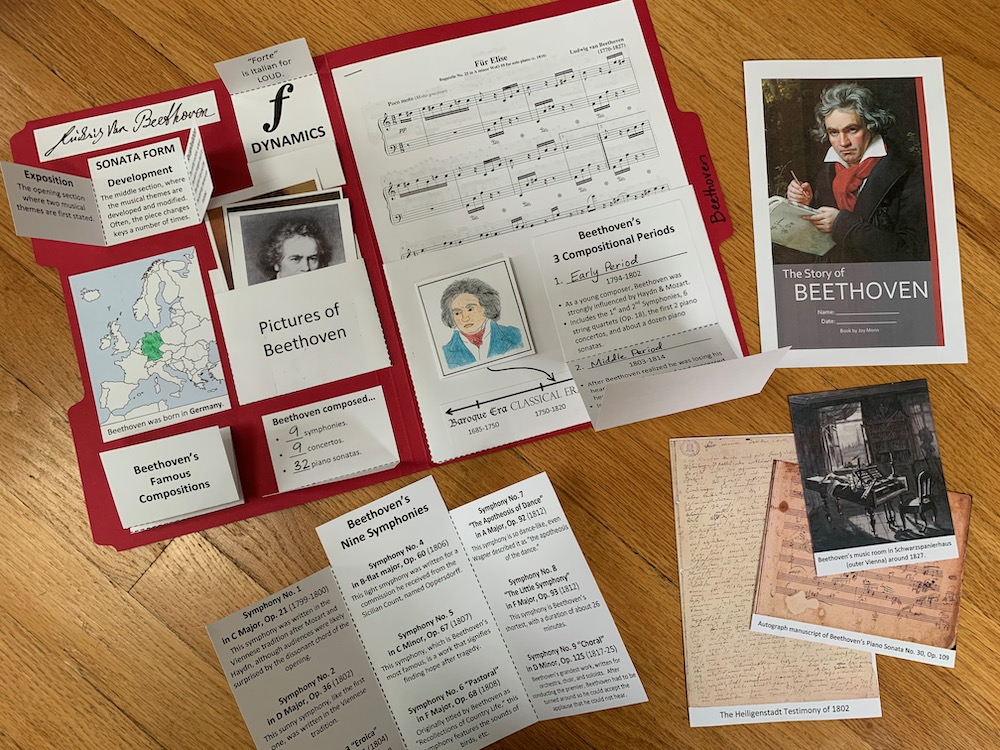
If you are thinking of holding a camp for the first time and are looking for an easy, complete curriculum, I would highly recommend holding a music history camp using my lapbook curriculum, “Great Composers and Their Music.” Read more about Music History Camp here. The curriculum is ready-to-go and students absorb SO much information when they learn through lapbooking.
Other camps I’ve offered in the past include So, You Want To Be A Composer?, Music of the World, and Musical Olympics.
Please share your thoughts about how to plan special camps/workshops in the comments. I would love to hear from you!
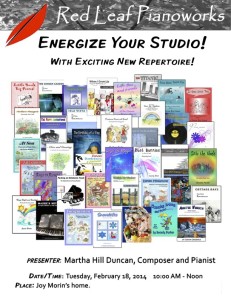 I love the internet. Without it, I would have far fewer friends and contacts in the piano teacher world, wouldn’t you?
I love the internet. Without it, I would have far fewer friends and contacts in the piano teacher world, wouldn’t you?
A few months ago, I connected with Canadian piano teacher and composer, Martha Hill Duncan. She stated that she would be in my area in February during her husband’s sabbatical and so I asked if she would be willing to give a presentation about the music of Red Leaf Pianoworks at my home. She said yes!
If you aren’t familiar with Red Leaf Pianoworks — It is a group of Canadian composers who collaborate to promote their self-published piano compositions. They have a website here and you may have seen them in the exhibit hall at conferences such as MTNA or NCKP.
Martha talked about the composers behind Red Leaf Pianoworks and demonstrated samples of their music for us. It was fun to learn a little about each person and get a taste of each person’s unique musical voice.
One of the things I noticed as I was listening to the pieces was how teachable the pieces were, while at the same time requiring students to get out of the typical five-finger positions that many American piano methods promote. I am always on the lookout for supplemental books that get students moving around the keyboard more.
Martha and my colleague try out a piano duet.
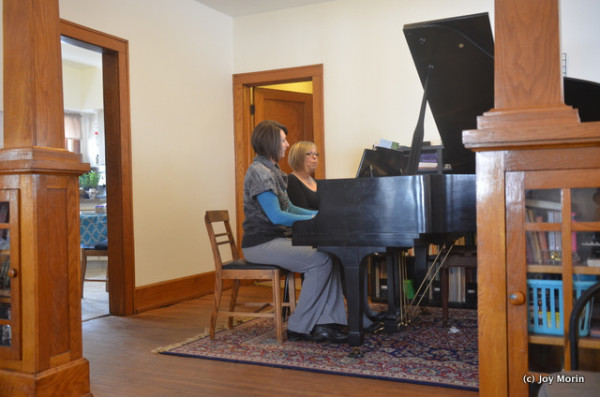
We had a lovely morning. Afterwards, Martha, her husband, and I went out for lunch.
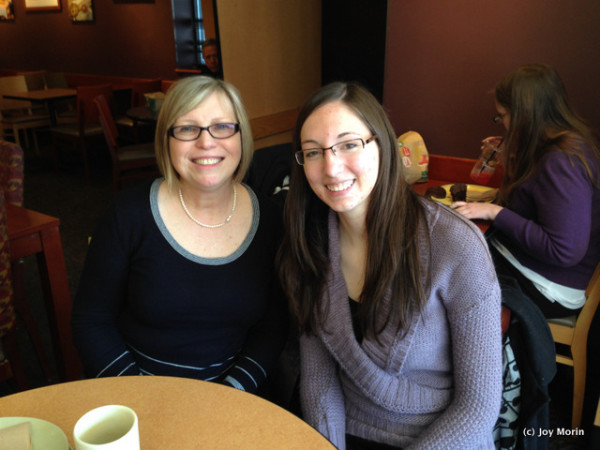
Be sure to check out the Red Leaf Pianoworks website here.
One of the questions I asked Martha was whether the Red Leaf Pianoworks has considered selling individual pieces as a PDF download from their website (and with the license for unlimited studio use — I love that!). She said they haven’t talked about it much but may consider it for the future. If this is something you would be interested in, leave a comment below to give Martha some feedback about this! I’m sure they would appreciate hearing from teachers.
Did you know that the authors of the Piano Adventures method, Nancy and Randall Faber, live in Ann Arbor, Michigan? Did you know that the Faber Piano Institute in Ann Arbor is only an hour away from where I live?!
My local MTNA chapter, the Wood-Ottawa Counties OhioMTA, organized a field trip for us to visit the Faber Piano Institute last Friday. We had a fantastic time. The Fabers and their staff were most welcoming and hospitable.
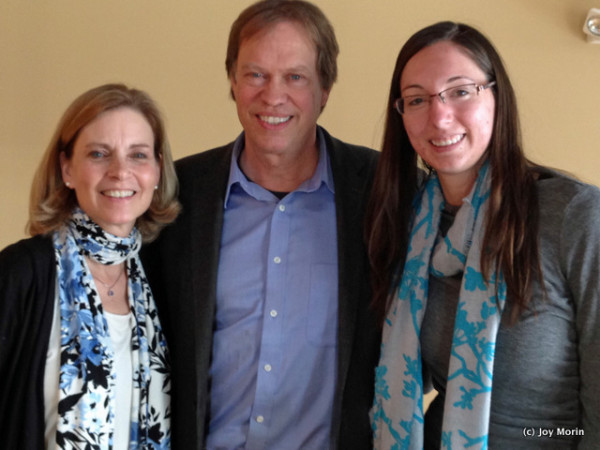
The Faber Piano Institute is located in a building that previously was a library. They created smaller rooms for teaching studios in one half of the building. There are around seven teachers who give lessons at the Faber Piano Institute. Continue reading “Field Trip to the Faber Piano Institute”
One of the questions that arose during the presentation about music games (see the handout here) that I gave last week for the Summit County OMTA chapter and at the 2014 MusicEdConnect.com conference was…
How do you organize your games?
You may remember some months back when I blogged about finding this little filing cabinet at a second-hand store. Here is how I decided to use all those wonderful drawers:
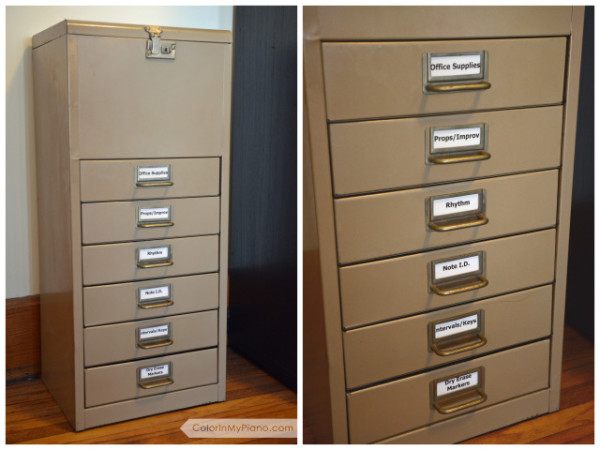
Those drawers contain materials for games that can be played during private lessons with students. It sits next to me where I teach at the piano. The six drawers are currently categorized:
You’ll notice that these categories align with the concepts listed in the handout. Games are most effective when we are choosing them in terms of the concepts they teach our students.
Here is the Props/Improv drawer:
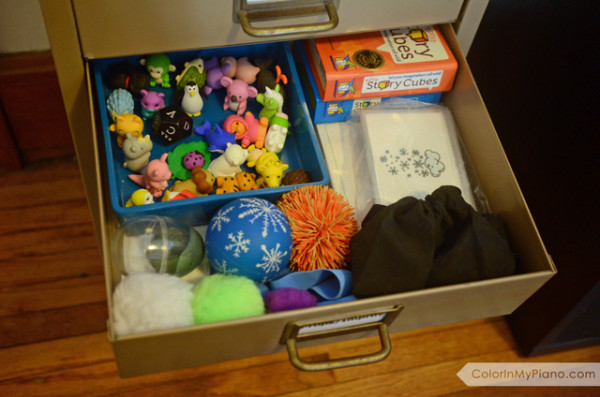
In the little black drawstring bag, I have a set of Scrabble tiles containing only the letters of the musical alphabet. I bought my Scrabble game used at Goodwill. I use the tiles as another way for students to randomly choose a letter of the musical alphabet (we sometimes use a spinner instead). They work great for The Amazing Keyboard Race, for example. Students can also sort the tiles onto the piano keys.

In the drawers across the room, I store my floor staff and the games that work only for group classes.

Please feel free to share in the comments about your organizational system!
P.S.: The live sessions may be over, but it’s not too late to register for the 2014 MusicEdConnect.com conference and have the opportunity to watch the session videos on your own time. Visit their website for more info.
I recently gave presentations about music games to the Summit County OhioMTA and the MusicEdConnect.com conference. I thought perhaps some of you might be interested in seeing the handout, which I have posted here on my personal website, joymorin.com. The links in the handout all lead directly to the games and printables being discussed. Enjoy!
Preview:
Building Musicianship Through Games & Activities
by Joy Morin
INTRODUCTION:
* * * * *
PART I: Considering the facets and goals of a teacher’s Teaching Philosophy.
The Teaching Philosophy states (1) the teacher’s GOALS for him-/her-self and the students, as well as, (2) HOW the teacher will lead students to achieve those goals.
Comprehensive musicianship involves:
PART II: Examples of games and activities that will help you accomplish the goals in your Teaching Philosophy.
Concept: MUSICAL ALPHABET
Concept: KEYBOARD TOPOGRAPHY
Read the rest here!
For Christmas, my husband gave me this handy little speaker: the Oontz Angle Wireless Bluetooth Speaker.
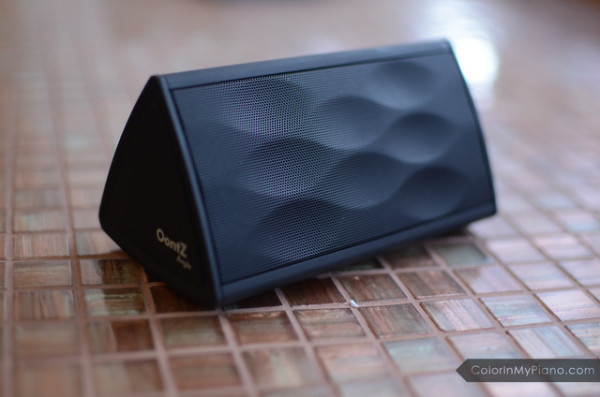
In the past, I always plugged a pair of old computer speakers into my iPhone, iPad Mini, or computer when I wanted to play music during lessons, group classes, or while cleaning the house. 🙂 They worked okay, but I found that if I turned the sound up too loud, the sound became distorted.
I am so pleased with this handy little speaker because I can turn the sound as loud as I need too without hearing distortion. I’m very pleased with the quality of the speaker!
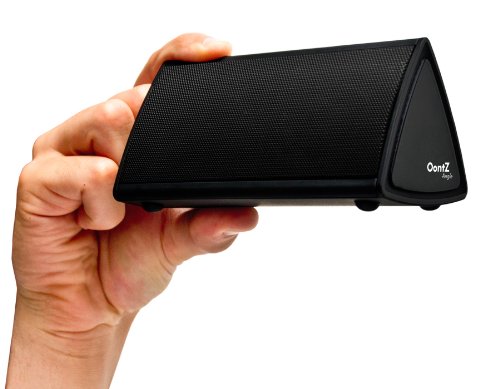
And, of course, it is handy that it is wireless. It connects via a bluetooth connection. Pairing the speakers to a device only takes a minute. Plus, it remembers what device you paired it with last and will automatically connect to that same device if both are turned on. I’ve owned bluetooth devices in the past and they did not connect this easily. Technology has certainly improved.
It comes with a USB cable so that you can recharge the battery by plugging it into your computer. The battery can last for up to 10 hours of playing time.
Just thought I’d share about this fun little gadget! Did you receive any Christmas gifts that have been useful for piano teaching? If so, please share about it in the comments!
My husband and I have just returned from a lovely, week-long vacation to Puerto Rico! It was such a blast. This was the first major vacation we have ever taken together. We enjoyed the culture, food, beach, and history of the island. The warm weather was such a welcome break from the freezing temperatures here in Ohio. 🙂 But I’m happy to be back!
As promised, here is the promo code for the February 20% off sale, in celebration of the 5-year blogiversary of ColorInMyPiano. You will need to enter the following code during check-out in order to receive the sale price. This sale won’t be back until next year, so plan ahead for your summer camps! Copy the code below and then click here to visit the shop.
The code will expire at the end of the month.
In other news: This week, I will be presenting at the MusicEdConnect.com online conference. Have you registered? My session, called “Building Musicianship Through Games & Activities,” will occur Thursday at 12:30pm EST. Hope to see you then!

On Friday, I will be traveling to Akron, Ohio to give a presentation for the Summit County OhioMTA chapter of MTNA. This presentation will be on the same topic — using games to develop complete musicianship in students. If any of you live near Akron and are interested in attending or are already planning to attend, let me know! You can send me an email message here.
Looking forward to a great week!
Guess what! February 28 marks the 5 year anniversary of this blog. How awesome is that?!
In celebration of the upcoming blogiversary, I wanted to announce that I will be holding a sale for the month of February: 20% off the items in the shop (ends February 28, 2014)! Stay tuned for the details. Perhaps you will want to start planning ahead for your summer camps so you can purchase some material while it is on sale. 🙂
February also brings Valentine’s Day. I thought I’d remind you that I have a couple of free piano-related Valentine printables available.
This is the valentine I designed last year. It is quick and easy to cut these out for your piano students. Click here to learn more.
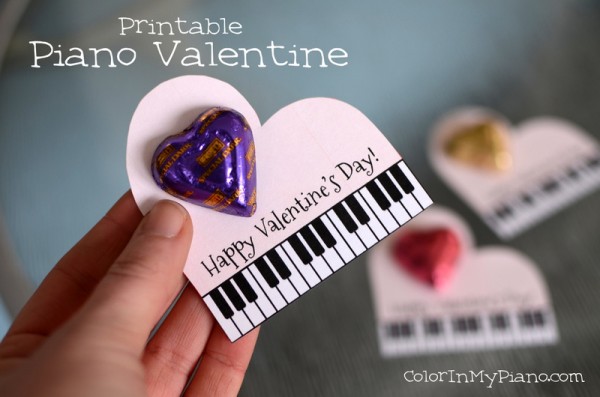
The valentine pictured below requires a little more assembly, but they are very cute. 🙂 Click here to learn more.
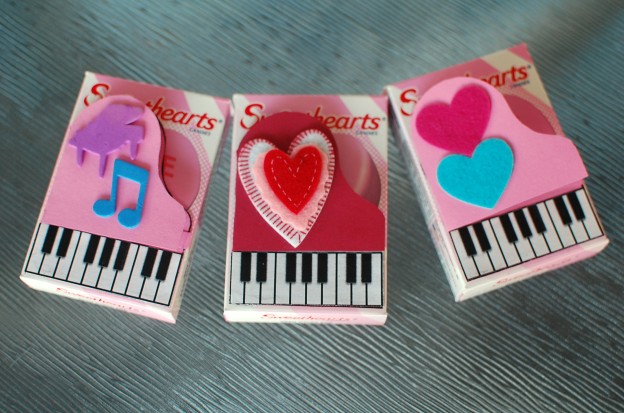
Your Cart is Empty